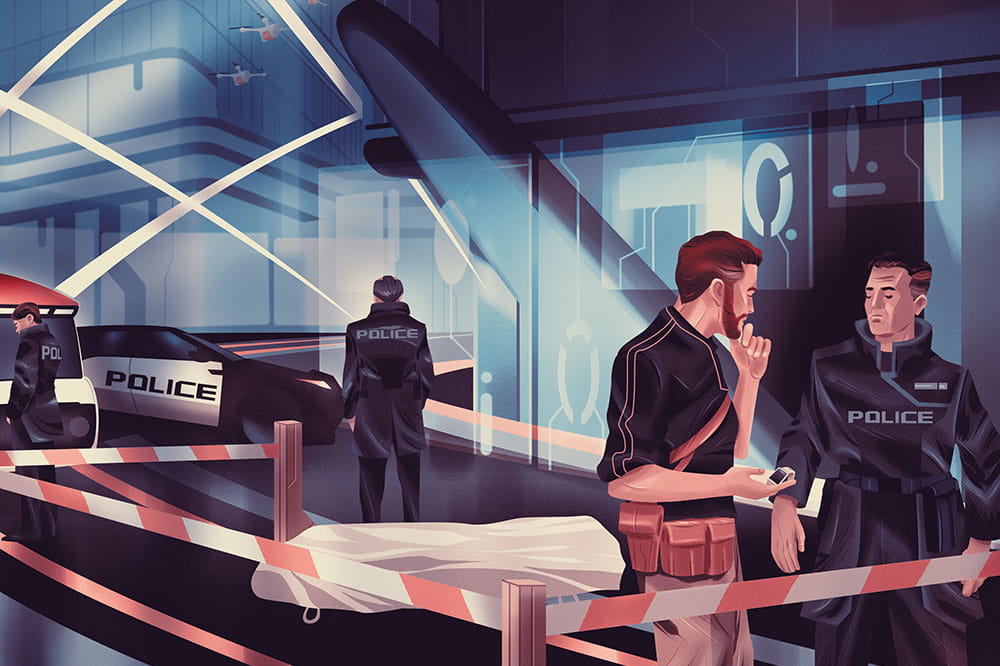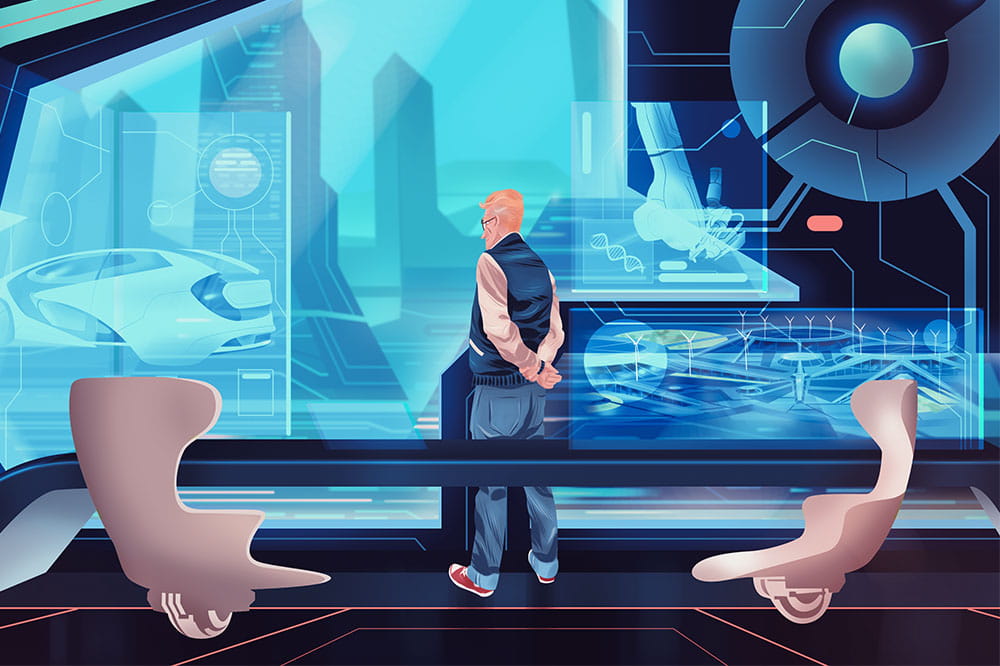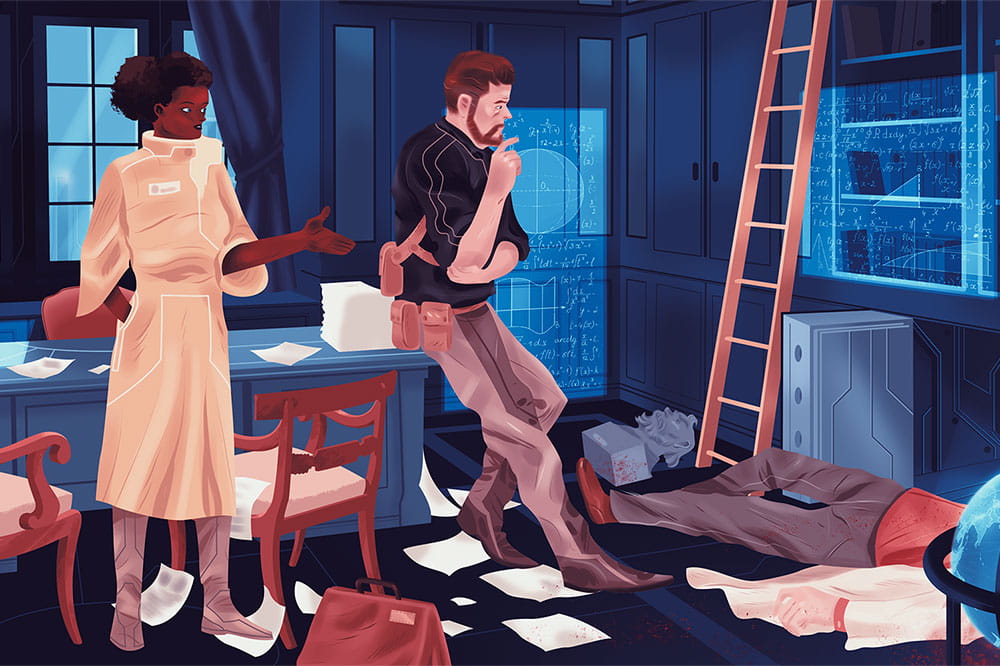Obtain news and background information about sealing technology, get in touch with innovative products – subscribe to the free e-mail newsletter.

TRAVELING INTO THE FUTURE
Each month, you can find a new chapter in the ESSENTIAL science-fiction series “Trip into the Future.” In a fictional world where the goals of the Paris climate accord have become a reality, Nero, a blogger, explores the potential technological and social transformation resulting from it. The goal of the series is to play with fully different visions as creatively as possible and to take the reader along on a thought experiment: What might our future look like – and why is it important to us?
Short Science Fiction Stories: Volume 2, Part 5
Desolate Game
Data scandal in Las Vegas: Several casino operators have been using monitoring devices and artificial intelligence to cheat their customers. Ironically, the scandal was discovered through the use of artificial intelligence. Hot on the trail of data activist Hanna Karlsen, Nero, an investigative blogger, decided to take a look around the desert metropolis.
It is indeed a comfortable way to travel: I covered the 2,500 miles from New York City to Las Vegas in a hyperloop capsule. The trip did in fact take three hours, but I had been getting sick more often on parabolic flights lately. Hyperloops are also wonderfully suited to work during travel. “Avar, please assemble all the documents that Hanna Karlsen published on the data scandal in Las Vegas,” I asked my AI assistant. “I’d be glad to, Nero,” she answered crisply, and went to work. The data activist Hanna Karlsen had recently been found dead. The police department’s artificial intelligence unit is assuming her death was a suicide, but Karlsen had told me she feared the system would retaliate against her. Since she played a major role in the discovery of the data scandal, Inspector Lee, the investigating officer, asked me to track down clues in Las Vegas.

Heat Sensors at the Roulette Table
The more I read Karlsen’s articles, the clearer the extent of the fraud became. Cameras microphones and other monitoring equipment had long been installed in Las Vegas casinos. Several operators had been using these masses of data to cheat customers. Using facial recognition, they developed movement profiles of their customers, along with detailed psychological studies. They rounded out the information with real-time data. For example, heat sensors were attached to the roulette tables to monitor the players’ body temperatures. Moisture sensors determined the amount of perspiration that their hands carried to the chips. The casinos were able to exactly predict what their customers would do next. According to Karlsen, it was even possible to predict whether a player would bet “odd” or “even” with a probability greater than 90 percent. On this basis, casino employees received precise instructions on what to do. For example, the AI software determined the exact time for the ball’s ejection to reduce the roulette player’s chance of winning.

Cave System Filled with Computing Centers
In Las Vegas, the computing power needed for these ploys is as plentiful as sand in the Nevada desert. And the metropolis has long been the AI capital of the world as well. No location has more computing power per square mile than Las Vegas. Certainly, the colorful LED lights and the many casino hotels on the Las Vegas strip still bear witness to the city’s past as a gambler’s paradise. But an entire network of caves filled with computing centers lies beneath the city. The centers were housed underground to protect quantum computers from the searing heat.
As I sped across the country in the hyperloop capsule, I looked out the virtual window, which offers a view outside thanks to cameras and slow-motion technology. Beyond the portals of the city, hundreds of square miles of desert are covered with solar foil, which provides electric current for energy-hungry computers. “Green AI – Made in Vegas” has become a model for the rest of the world. The city converted to a new water supply system after Lake Mead dried up. Huge pumps transport seawater through pipelines. across the desert, where it is desalinated and processed with an evaporation system and several ion filters. As I took another look at the membrane-covered evaporation pools, Avar announced our imminent arrival in Las Vegas.
One AI Unearths Another
I was due to meet with Peter Cunning, the head of the taxation authority for the North American Confederation, which moved its headquarters to Las Vegas a few years ago to take advantage of the massive computing power there. This was the agency that discovered the data scandal after receiving tips from Hanna Karlsen. Once the agency’s AI unit compared the profitability trends of a number of casinos, it discovered irregularities. The profitability time curves for a half-dozen casinos differed sharply from the rest, even though every possible ancillary effect had been taken into account. The investigating AI unit concluded that only another AI entity could be behind the scandal. Casinos had been barred from using AI software some years earlier, though consumer protection groups had criticized the close proximity of the computing centers to the casinos right from the start.
The tax agency occupied a black, multi-layered building. I recognized the design from my travels in hot regions: The heat is absorbed and then, with the help of evaporation and several heat exchangers, is used to cool the building. The requisite solar electricity comes directly from the façade, which also serves as an energy storage unit. Cunning was at the entrance waving to me as I arrived. We shook hands.

“It is really something for one artificial intelligence entity to unmask another,” I said approvingly.
“It is indeed,” Peter confirmed. “Our AI unit was only able to uncover the scandal with the help of our quantum computer. And it was only the Grover algorithm that allowed us to go through the casino operators’ extremely large databases.”
“How important was the tip from Hanna Karlsen?” I asked.
“It was crucial as well,” Peter said, after briefly considering the question. “Incidentally, our quantum computer noticed something else.”
I looked at Peter, intrigued.
“We picked up signals from the retro smartwatch that Hanna was wearing on her wrist during her last visit. Its antitheft device was sounding a continual alarm. And our computer determined that the device seriously impaired the smartwatch’s smart-health algorithms.”
“That is strange,” I said. “I’ll have to tell Inspector Lee about this.”
More Stories About Future Files

Join Us!
Experience Freudenberg Sealing Technologies, its products and service offerings in text and videos, network with colleagues and stakeholders, and make valuable business contacts.
Connect on LinkedIn! open_in_new









